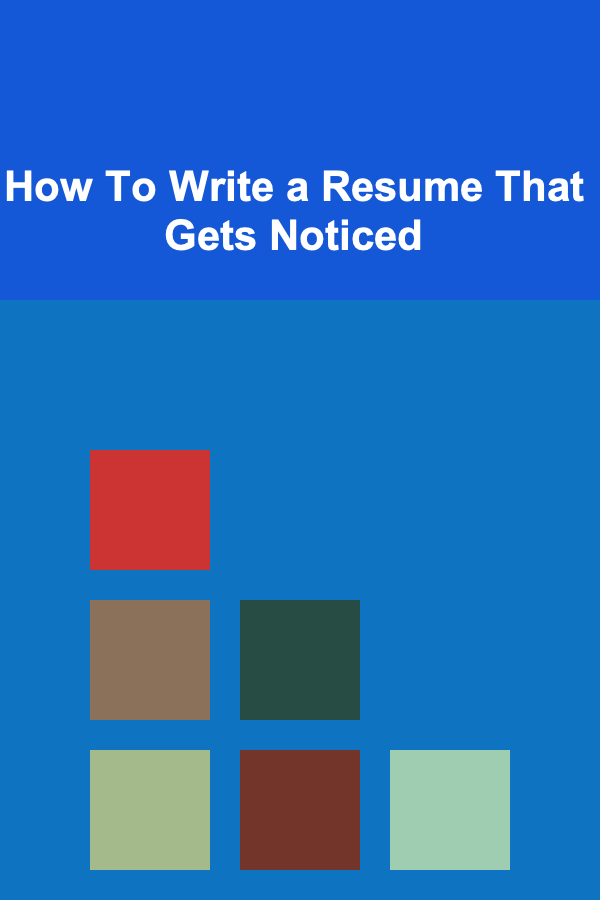
How To Write a Resume That Gets Noticed
ebook include PDF & Audio bundle (Micro Guide)
$12.99$9.99
Limited Time Offer! Order within the next:

In today's competitive job market, your resume is often the first and sometimes the only opportunity you get to make an impression on a potential employer. Crafting a resume that stands out can be the key to landing an interview and ultimately securing a job. Whether you are a fresh graduate entering the workforce for the first time or a seasoned professional looking to switch careers, a well-written and thoughtfully designed resume can make a world of difference. But what makes a resume truly stand out? In this comprehensive guide, we will explore how to write a resume that gets noticed, breaking down the essential components, offering tips for customization, and addressing common mistakes to avoid.
Understand the Purpose of a Resume
A resume's primary goal is simple: to communicate your qualifications, skills, experience, and achievements in a clear and concise format that appeals to potential employers. However, a resume is not just a list of jobs you've held. It's a marketing document that aims to showcase why you are the best candidate for a particular role.
Before diving into writing, it's essential to understand the purpose of your resume from the perspective of the hiring manager. Hiring managers often sift through dozens, if not hundreds, of resumes for a single position. They are looking for the most relevant and impactful information that demonstrates your ability to contribute effectively to their team and organization. Your resume should be designed to capture attention quickly, highlight your most valuable assets, and persuade them that you are worth interviewing.
Research the Job and Company
One of the most important steps in creating a resume that stands out is ensuring that it aligns with the specific job and company you are applying to. Every job posting will have specific requirements, such as skills, experiences, and qualifications. Understanding these requirements, as well as the company's culture, values, and objectives, is crucial for tailoring your resume effectively.
Tailoring to the Job Description
Every resume should be customized to suit the job you're applying for. Take the time to carefully read the job posting and identify the most important skills, experiences, and qualifications the employer is seeking. Highlight these in your resume, and try to incorporate keywords from the job description. Many companies use applicant tracking systems (ATS) to filter resumes before a human even sees them. Including the right keywords helps ensure your resume is noticed by the ATS and passed on to the hiring manager.
Understanding the Company's Culture
In addition to analyzing the job description, consider the company's culture and the role it is hiring for. Research the company's mission statement, values, and any information about its work environment that you can find on their website or social media profiles. This will help you decide how to frame your skills and experience to appeal to the company's specific needs and corporate culture.
Start with a Strong Resume Summary or Objective
The first section of your resume is critical because it sets the tone for everything that follows. It's important to start with a strong opening statement that clearly communicates who you are and what you bring to the table. There are two common types of openings: the resume summary and the resume objective.
Resume Summary
A resume summary is a brief overview (usually 2--3 sentences) that highlights your most important skills, qualifications, and accomplishments. This is ideal for individuals with some experience in the field, as it quickly establishes what value you can bring to the company. A well-crafted summary should focus on your key strengths, such as leadership, technical skills, or industry expertise, and showcase how these strengths align with the job you're applying for.
Example: "Results-driven marketing professional with 5+ years of experience in digital marketing and social media strategy. Proven track record of increasing brand engagement by 30% through targeted campaigns and data-driven decision-making. Adept at creating compelling content and optimizing paid media strategies for improved ROI."
Resume Objective
A resume objective, on the other hand, is more suited to entry-level candidates or individuals switching careers. It typically focuses on your career goals and how you plan to use your skills to contribute to the organization. An objective statement should express enthusiasm for the position and outline what you hope to achieve in the role.
Example: "Motivated recent graduate with a degree in Computer Science seeking a software development role to apply coding skills and problem-solving abilities in a dynamic team environment. Eager to contribute to innovative projects and grow professionally within a leading tech company."
Highlight Key Skills and Competencies
In the skills section of your resume, it's important to highlight both hard and soft skills that are relevant to the job. Employers want to see that you possess the technical expertise to perform the job effectively, as well as the interpersonal qualities necessary for collaboration and leadership.
Hard Skills
Hard skills are specific, teachable abilities that can be quantified. These often include technical proficiencies, certifications, and tools you've mastered. Examples of hard skills include:
- Programming languages (e.g., Python, JavaScript, SQL)
- Project management tools (e.g., Asana, Trello, Jira)
- Graphic design software (e.g., Adobe Photoshop, Illustrator)
- Data analysis (e.g., Excel, SPSS, Tableau)
- Languages (e.g., Spanish, Mandarin, French)
Soft Skills
Soft skills refer to your personal attributes and interpersonal skills, which are harder to quantify but equally important in many roles. These skills often include communication, teamwork, problem-solving, and leadership. Examples of soft skills include:
- Communication (verbal and written)
- Time management
- Collaboration and teamwork
- Critical thinking and problem-solving
- Adaptability and flexibility
By showcasing a balanced mix of hard and soft skills, you demonstrate that you are both technically capable and a strong cultural fit for the team.
Experience Section: Show, Don't Just Tell
Your work experience is one of the most important sections of your resume, and it's essential to go beyond simply listing your job duties. Employers want to see how you contributed to your previous organizations and what impact you made. Use action-oriented language and quantify your achievements wherever possible.
Use Action Verbs
Start each bullet point with a strong action verb to make your accomplishments stand out. Examples include "led," "developed," "managed," "increased," "streamlined," and "improved." These action verbs convey that you were an active participant in achieving results, not just a passive observer.
Quantify Achievements
Whenever possible, include numbers, percentages, or other concrete figures to highlight your successes. Quantifying your achievements makes them more tangible and helps employers understand the scale of your impact.
Example:
- Increased annual sales by 20% through the implementation of a new customer outreach program.
- Managed a team of 10 employees to successfully complete 15+ projects on time and under budget.
- Reduced operational costs by 15% by optimizing supply chain processes.
Tailor Experience to the Job
You don't need to list every job you've ever had. Instead, focus on your most recent and relevant positions that align with the job you're applying for. For each role, emphasize the skills and experiences that match the job requirements. If you're applying for a project management position, for example, highlight your experience managing teams, budgets, and timelines.
Education: Show Off Your Credentials
Your educational background is another essential part of your resume, especially if you're early in your career or the position requires specific qualifications. Include details such as:
- The name of the school or university
- The degree(s) you obtained (or are in the process of obtaining)
- Your graduation date (or expected graduation date)
- Relevant coursework (if applicable)
If you have a degree that's particularly relevant to the position, you may want to place it closer to the top of your resume. Otherwise, it's typically placed towards the end of the document.
Additional Certifications and Training
In addition to your formal education, consider listing any certifications or professional development courses you have completed that are relevant to the job. Examples might include:
- Project Management Professional (PMP)
- Google Analytics Certification
- Microsoft Certified Solutions Expert (MCSE)
- Scrum Master Certification
Certifications demonstrate your commitment to continuous learning and can be an essential differentiator when applying for roles in fields that require specific expertise.
Design and Formatting: Make It Clean and Easy to Read
Even the best-written resume can be overlooked if it's poorly formatted or difficult to read. Keep your design clean and simple, and make sure that the most critical information stands out.
Use a Professional Font
Choose a professional, easy-to-read font like Arial, Helvetica, or Calibri. Font sizes should typically be between 10 and 12 points for the body text, with larger sizes (14 to 16 points) for section headings.
Keep It to One or Two Pages
While there's no strict rule about the length of a resume, one or two pages is generally the sweet spot. If you're early in your career, one page may be enough to showcase your qualifications. If you have more extensive experience, you can extend to two pages, but ensure that every section adds value and relevance.
Use Bullet Points
Use bullet points to break down your responsibilities and achievements. This makes it easier for hiring managers to scan your resume quickly. Keep your bullet points short and to the point.
Consistent Layout
Make sure your resume has a consistent layout throughout, with clear section headings and proper spacing. Use bold, italics, and underlining sparingly to highlight important information.
Proofread and Edit
One of the biggest mistakes candidates make is submitting a resume with spelling or grammatical errors. Errors like these create a negative impression and can hurt your chances of landing an interview.
After writing your resume, take the time to thoroughly proofread it. Use a spell checker, but also read through the document carefully yourself, as automated tools can miss subtle errors. If possible, have a trusted friend or colleague review it as well. Fresh eyes can often catch mistakes that you might have missed.
Common Mistakes to Avoid
- Typos and grammatical errors: As mentioned earlier, mistakes like these can significantly hurt your chances.
- Including irrelevant or outdated information: Focus on recent and relevant experience. If you've been working for several years, there's no need to include every job you've had since high school.
- Using a one-size-fits-all approach: Customization is key. Tailor your resume for each job you apply to by adjusting your experience and skills to match the job description.
- Using overly complex language or jargon: Keep it clear and simple. Avoid using overly technical terms unless necessary for the position.
Conclusion
Writing a resume that gets noticed requires more than just listing your work experience. It involves presenting your qualifications and achievements in a way that clearly communicates your value to potential employers. By tailoring your resume to the job, highlighting your most relevant skills and accomplishments, and following best practices for formatting and design, you can craft a resume that stands out in today's competitive job market. Take the time to customize your resume for each job application, and remember to proofread carefully before submitting it. A well-crafted resume can be the first step towards landing your dream job.
Reading More From Our Other Websites
- [Home Soundproofing 101] How to Soundproof Your Home on a Tight Budget
- [Personal Financial Planning 101] How to Build a Personal Budget That Works for Your Lifestyle
- [Organization Tip 101] How to Choose the Right Appliances for Your Outdoor Kitchen
- [Personal Financial Planning 101] How to Begin Understanding Mutual Funds and Their Role in Diversifying Your Portfolio
- [Mindful Eating Tip 101] Mindful Eating for Seniors with Dietary Restrictions: Balancing Flavor and Health
- [Home Holiday Decoration 101] How to Create a Budget-Friendly Holiday Decor Plan for Your Entire Home
- [Organization Tip 101] How to Build a Family Reunion Committee for Effective Planning
- [Home Budget Decorating 101] How to Choose and Style Affordable Throw Pillows for Your Sofa
- [Personal Care Tips 101] How to Use Mouthwash Effectively for Fresh Breath and Oral Health
- [Home Pet Care 101] How to Keep Your Home Clean and Pet-Friendly: A Guide to Safe Cleaning Products

How to Avoid Impulse Buying and Stick to Your Budget
Read More
How to Clean Stainless Steel Appliances Without Scratching
Read More
How to Inspect and Maintain Your Home's Foundation for Cracks
Read More
How to Master Coffee Bean Sourcing
Read More
How to Build a Small-Scale Solar Water Heater
Read More
10 Tips for Maximizing Tax Deductions on Accounting Fees
Read MoreOther Products

How to Avoid Impulse Buying and Stick to Your Budget
Read More
How to Clean Stainless Steel Appliances Without Scratching
Read More
How to Inspect and Maintain Your Home's Foundation for Cracks
Read More
How to Master Coffee Bean Sourcing
Read More
How to Build a Small-Scale Solar Water Heater
Read More